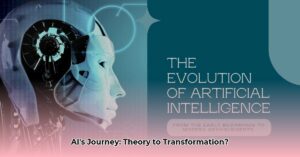AI Accelerates Evolution: A New Protein Emerges
Scientists have harnessed the power of artificial intelligence to mimic and accelerate evolution, creating a novel, fluorescent protein unlike any found in nature. Published in Science, this breakthrough involves an AI called ESM3, effectively simulating 500 million years of natural selection within a computer. This article explores how this groundbreaking technology works, its potential applications in medicine and environmental research, and the ethical considerations that arise from giving AI the reins of evolution.
Deciphering Life’s Code: How ESM3 Learns
ESM3 is a sophisticated language model trained on a vast database of protein sequences, structures, and functions, encompassing 771 billion data points. This “digital library of life,” representing roughly 500 million years of evolutionary information, allows ESM3 to discern the intricate relationships between a protein’s genetic code (sequence), its 3D shape (structure), and its biological role (function). This comprehensive understanding empowers ESM3 to design entirely new proteins from scratch.
esmGFP: A Beacon of AI-Driven Innovation
The creation of esmGFP, a fluorescent protein unlike any found in nature, validates ESM3’s potential. This achievement highlights the AI’s ability to generate proteins with tailored properties, opening exciting possibilities for designing highly specific disease treatments, sensitive environmental biosensors, and more.
ESM3’s Unique Power: A Multifaceted Approach
ESM3’s strength lies in its ability to consider sequence, structure, and function simultaneously, unlike earlier AI models that often focused on only one or two of these aspects. This holistic approach provides a deeper understanding of protein dynamics, enabling precise design. ESM3 effectively simulates biological evolution within a computer, dramatically accelerating the process and potentially exploring evolutionary paths nature hasn’t yet traversed.
Democratizing Protein Engineering: Open Access to ESM3
ESM3 is available in beta form through an API and as open-source code, making it accessible to researchers worldwide. This democratization of protein engineering could usher in an era where designing custom-made proteins becomes as commonplace as writing software.
Navigating the Ethical Landscape of AI-Driven Evolution
The power of AI-driven evolution necessitates careful consideration of its ethical implications. Questions surrounding the potential downsides of designing novel proteins and ensuring responsible use of this transformative technology require thoughtful discussion and proactive guidelines.
| Feature | Description |
|---|---|
| Data Input | Protein sequences, structures, and functions (771 billion data points) |
| Model Type | Multimodal generative language model |
| Key Capability | Designs novel proteins with specific properties (e.g., fluorescence) |
| Example Output | esmGFP (a new fluorescent protein) |
| Accessibility | Open-source code and API available in beta |
| Implications | Potential advancements in medicine, environmental research, and other scientific fields |
Current research suggests that while ESM3 can generate novel proteins, further investigation is needed to fully understand their long-term stability and behavior. Questions also remain about the limits of AI-driven evolution – can it truly replicate the complexity and serendipity of natural selection? Ongoing research will likely provide further insights and refine our understanding of AI’s role in shaping the future of biology.
Understanding AI-Driven Evolution
AI-driven evolution uses artificial intelligence to accelerate and direct the evolutionary process, specifically in crafting new proteins with tailored properties. Unlike natural evolution, which unfolds over millions of years, AI can achieve similar results in a significantly shorter timeframe. ESM3, for instance, simulated 500 million years of evolution to create the novel fluorescent protein esmGFP, demonstrating the potential to revolutionize fields like medicine and environmental science.
ESM3, trained on a massive dataset of protein information, functions as a specialized language model understanding the intricate language of proteins. By grasping the relationships between a protein’s building blocks, its 3D structure, and its biological function, ESM3 can predict evolutionary pathways and design entirely new proteins. This capability opens doors to countless applications, from personalized medicine to crops engineered for harsh climates, but also raises ethical considerations surrounding responsible development and potential misuse. Ongoing research will likely reveal further insights into the capabilities and limitations of AI-driven evolution.
Simulating 500 Million Years of Evolution: How Does it Work?
ESM3, developed by EvolutionaryScale and the Arc Institute, acts as a powerful analytical tool, examining a vast database of protein information spanning roughly 500 million years of evolution. This database, containing the equivalent of 771 billion words of information, comprises 3.15 billion protein sequences, 236 million protein structures, and 539 million protein annotations. ESM3 doesn’t simply store this data; it learns from it, deciphering the underlying rules of protein evolution.
Unraveling the Complexity of Protein Evolution
ESM3 utilizes a “multimodal” approach, considering a protein’s sequence, structure, and function simultaneously. This holistic perspective allows it to grasp the complex interrelationships between these elements, enabling more sophisticated and lifelike simulations of evolution compared to previous models that primarily focused on sequence alone.
esmGFP: A Testament to AI’s Evolutionary Power
The creation of esmGFP, a novel fluorescent protein not found in nature, showcases ESM3’s ability to invent proteins from scratch. This achievement highlights the transformative potential of AI-driven protein engineering, suggesting possibilities for designing proteins with specific functions for various applications, from targeting cancer cells to breaking down environmental pollutants.
Democratizing Discovery: Open Access to ESM3
The researchers have made ESM3 publicly accessible through an API, allowing scientists and others to harness its power for protein design experiments. This open access could accelerate discoveries in diverse fields, from medicine and pharmaceuticals to environmental science and materials engineering.
Ethical Considerations and Responsible Development
While the potential of ESM3 is vast, its use raises ethical considerations. The creation of entirely new proteins prompts questions about potential unforeseen consequences and the need for responsible research and development practices. Ongoing dialogue and careful consideration of the potential ramifications are crucial as this technology progresses.
Applications of AI-Driven Protein Design
AI-driven protein design, effectively accelerating evolution, has far-reaching implications across diverse fields. By utilizing evolutionary algorithms, scientists can now create proteins with specific abilities in a fraction of the time it would take nature. This process involves iterative cycles of testing, selection, mutation, and recombination, guided by AI’s predictive power.
ESM3: A Catalyst for Innovation
ESM3’s creation of the novel fluorescent protein esmGFP demonstrates the power of AI-driven protein design, opening doors to a wide range of applications.
Real-World Applications
- Medicine: AI-designed proteins offer the potential for targeted therapies, tissue repair, and accelerated drug discovery, with examples including designer antibodies, therapeutic enzymes, and novel vaccines.
- Environmental Science: AI could revolutionize pollution control, bioremediation, and environmental monitoring through the development of plastic-degrading enzymes and toxin-detecting biosensors.
- Industrial Biotechnology: AI-designed proteins can enhance biofuel production, biomaterial development, and the creation of efficient industrial enzymes, leading to innovations like enhanced biocatalysts, novel bioplastics, and more efficient biofuel production.
| Area of Application | Potential Impact | Examples |
|---|---|---|
| Medicine | Targeted therapies, tissue repair, drug discovery | Designer antibodies, therapeutic enzymes, novel vaccines |
| Environmental Science | Pollution control, bioremediation, environmental monitoring | Plastic-degrading enzymes, toxin-detecting biosensors |
| Industrial Biotechnology | Biofuel production, biomaterial development, industrial enzymes | Enhanced biocatalysts, novel bioplastics, efficient biofuel production |
Challenges and Future Directions
Despite the promise, challenges remain, including computational costs and the ongoing development of accurate protein behavior prediction. However, continued advancements in AI models and computational power are expected to drive further breakthroughs. Ongoing research suggests that the possibilities are vast, limited only by our imagination and the ethical considerations that guide responsible development.
Ethical Implications of AI-Powered Evolution
The ability of AI to accelerate evolution, as demonstrated by ESM3’s creation of a novel fluorescent protein, raises significant ethical questions. While offering immense promise for medical advancements, environmental solutions, and more, this technology also presents potential risks that demand careful consideration.
AI-driven evolution, functioning as a powerful prediction tool, raises concerns about potential misuse, such as the development of dangerous bioweapons or the accidental triggering of ecological disasters. The ethical challenge lies in balancing the potential benefits with the inherent risks.
Bias in AI models, stemming from the data they are trained on, is another concern. This bias could lead to unintended consequences, such as favoring certain species or exacerbating societal inequalities. Furthermore, the lack of transparency in some AI systems makes it difficult to fully understand their decision-making processes, raising questions about trust and the ability to identify and correct potential biases.
Navigating the ethical landscape of AI-powered evolution requires robust regulations, clear ethical guidelines, and open public discourse. International cooperation might be necessary to establish these guidelines, ensuring responsible development and application of this powerful technology. The long-term consequences and potential unintended side effects necessitate ongoing monitoring, ethical reassessment, and a willingness to adapt as our understanding of AI evolves. The future of AI-powered evolution is a shared responsibility, demanding thoughtful consideration and proactive measures to ensure its beneficial use for humanity.
| Potential Benefit | Potential Risk | Ethical Consideration |
|---|---|---|
| New disease treatments | Unforeseen bioweapon development | Strict regulation and oversight |
| Environmental cleanup solutions | Accidental ecological disruption | Thorough environmental impact assessments |
| Sustainable biofuel development | Exacerbation of existing societal inequalities | Equitable access to benefits |
| Accelerated drug discovery | Loss of natural biodiversity | Preservation of natural evolutionary processes |
| Improved agricultural practices | Unintended consequences for food webs | Careful ecological monitoring |
| New materials with novel properties | Creation of harmful or uncontrollable substances | Responsible research and development practices |
Ongoing research and open discussion are crucial to navigating the complex ethical considerations surrounding AI-powered evolution. The future of this technology is not predetermined; it’s a future we are actively shaping with our choices today.




1 thought on “AI Simulates 500 Million Years of Evolution, Creating Novel Protein”
Comments are closed.